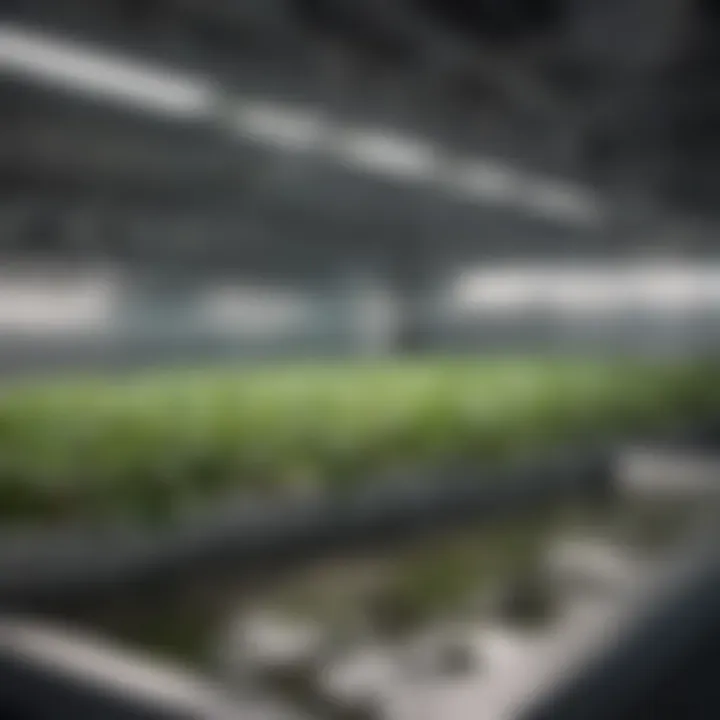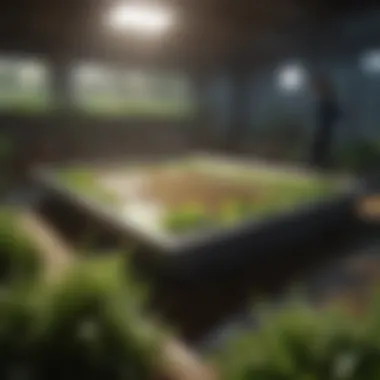Exploring Botanicare Flood Tables in Modern Agriculture


Intro
In the contemporary landscape of agriculture, efficient resource management is paramount. The rise of hydroponics and aquaponics as viable farming methods reflects an urgent need for sustainable practices. Central to these systems is the use of flood tables, particularly those designed by Botanicare. Their innovative approach to water and nutrient delivery systems catalyzes growth in diverse agricultural contexts. The ensuing discussions will navigate through the design, applications, and maintenance of these flood tables, emphasizing their significance for modern farming.
Topic Overview
Definition and Importance
Flood tables are specially designed containers that facilitate the irrigation of plants through an automated system. They ensure uniform water distribution, optimizing the uptake of nutrients. The importance of flood tables lies in their ability to support controlled environments for plant growth, especially where traditional soil farming presents limitations. With increasing pressure on food production, these tables offer an effective solution for maximizing yield with minimal environmental impact.
Brief History and Evolution
The concept of using water as a direct medium for plant cultivation is not new. Historically, cultures such as the Chinese and the Aztecs employed variations of these methods. However, Botanicare has refined this approach with modern materials and technologies. Their flood tables have evolved to include features that enhance durability, ease of use, and functionality, catering specifically to hydroponic and aquaponic systems.
Key Techniques and Innovations
Sustainable Farming Practices
Botanicare flood tables are a cornerstone of sustainable agricultural methods. They enable farmers to recycle water, thereby minimizing waste. The integration of these systems allows for precise control over water and nutrient delivery, promoting resource efficiency. This support for sustainable practices is crucial as agriculture faces the dual challenges of climate change and dwindling natural resources.
Advanced Agronomic Technologies
Utilizing cutting-edge technology, Botanicare's flood tables include innovations such as automated timers and sensors. These tools help in monitoring and adjusting water levels and nutrient concentrations in real-time, enhancing plant health and yield. With precision agriculture being at the forefront of modern farming, these technologies are indispensable for farmers looking for scalable solutions in a competitive market.
Practical Applications
Step-by-Step Guides
Implementing a Botanicare flood table system typically involves several steps:
- Select the Right Size: Choose a flood table that fits your available space and meets your production goals.
- Setup the Plumbing: Connect the flood table to a reliable water source.
- Fill with Growing Medium: Common choices include clay pellets, rockwool, or expanded glass.
- Position the Plants: Arrange transplants or seeds evenly across the table.
- Adjust the Timer: Set the flood and drain cycle according to plant needs, ensuring adequate moisture.
By following these steps, growers can achieve optimal conditions for plant growth.
Case Studies or Real-World Examples
Numerous cases illustrate the efficacy of Botanicare flood tables in practice. For instance, a hydroponic farm in California reported a 30% increase in tomato yield after implementing this system. Another case involving lettuce production demonstrated a significant reduction in water usage compared to traditional soil farming.
These real-world applications underscore the role that flood tables can play in enhancing agricultural productivity while promoting sustainability. The versatility present in these setups can serve varying crops and environments, proving beneficial in both commercial and personal farming projects.
"Sustainable practices in agriculture will be decisive in the future of food production, and tools like Botanicare flood tables are essential in this transition."
Preface to Botanicare Flood Tables
Botanicare flood tables play a critical role in modern hydroponic and aquaponic systems. They maximize space and efficiency for plant growth while optimizing resource use, particularly water and nutrients. In a time where sustainable agriculture is paramount, understanding the functionality and purpose of these flood tables is invaluable for farmers and agricultural enthusiasts alike. This introduction not only sets the stage for examining Botanicare’s offerings but also highlights the intersection between technology and agronomy that is reshaping cultivation practices.
Definition and Purpose
Botanicare flood tables are designed to facilitate the process of hydroponic growing. These tables provide a platform where plants can be grown without soil, relying on a nutrient-rich water solution instead. Essentially, a flood table consists of a flat tray that floods with water at scheduled intervals, allowing roots to absorb essential nutrients and oxygen. The primary purpose of these tables is to enhance plant growth while minimizing the usage of water, making them an essential tool in the realm of sustainable agriculture.
The design enables efficient water delivery, ensuring all plants receive adequate moisture. This system also reduces water waste and optimizes nutrient distribution, allowing for quicker growth cycles compared to traditional soil-based farming. Furthermore, flood tables can be used in various setups, be it a small indoor garden or large-scale agricultural operations, highlighting their versatility and adaptability.
Historical Background of Hydroponics
The concept of hydroponics can be traced back centuries. Early documentation shows that ancient civilizations, such as the Babylonians, utilized similar techniques for growing plants in soil-less environments. However, modern hydroponics began to take shape in the 1930s with advancements in plant nutrition research. Scientists discovered that plants do not need soil to grow; instead, they require essential nutrients that can be provided through water.
In the latter half of the 20th century, hydroponic systems flourished due to technological advancements and increasing food demand. Innovations in growing systems, such as the introduction of flood and drain methods, paved the way for effective cultivation. As awareness of environmental issues rose, hydroponics became a favored method for sustainable farming practices. Today, Botanicare flood tables embody this rich history, combining decades of research and development into efficient growing solutions that cater to contemporary agricultural needs.
"Hydroponics is more than just growing plants; it's about nurturing a sustainable future for food production."
In summary, Botanicare flood tables are a significant aspect of hydroponics that provide essential resources for plants while supporting sustainable agricultural practices. Understanding their definition and historical context gives us a solid foundation for exploring their unique features and applications in modern farming.
Understanding Flood Tables in Hydroponics
Flood tables play a critical role in the realm of hydroponics, particularly within the context of modern agriculture. They are essential for effective nutrient delivery and water management, making them indispensable for both commercial and home growers. Knowing how these systems work provides insight into their advantages, including enhanced efficiency and sustainability. This section focuses on the basic operating principles of flood tables and the different flooding mechanisms available, which enrich the understanding of hydroponic practices.
Basic Operating Principles
Flood tables utilize a straightforward yet effective mechanism to promote optimal plant growth. These tables consist of a flat surface, which holds the growing medium or plants, and a reservoir underneath that stores nutrient-rich water. The basic operation involves periodic flooding of the growing area, where water and nutrients are distributed to the plants. After flooding, the water drains back into the reservoir, allowing the plants to absorb the nutrients without waterlogging.
This cycle is not only efficient but also minimizes waste. By controlling the duration and frequency of floods, growers can tailor the irrigation to the specific needs of the plants, leading to improved growth. Additionally, this system encourages root growth while preventing diseases associated with overwatering. It is crucial for practitioners to understand how to balance flooding and draining times to optimize plant health and resource use.
Types of Flooding Mechanisms
Flood systems can vary greatly in their design and operation. Understanding the different types of flooding mechanisms can help growers choose the right system for their specific needs:


- Timed Flood Systems: These employ a timer to control when to flood and drain, allowing for precise management of the irrigation schedule.
- Continuous Flow Flood Systems: This mechanism involves a constant flow of water, ensuring plants receive a steady supply of nutrients. However, it requires careful monitoring to avoid overwatering.
- Ebb and Flow Systems: This type is characterized by intermittent flooding and draining. It is popular due to its simplicity and adaptability to various plant types.
"The correct management of flooding and draining times leads to enhanced growth and sustainability in hydroponics."
By grasping these concepts, farmers and enthusiasts can leverage flood tables more effectively, maximizing their agricultural output while maintaining eco-friendly standards.
Botanicare’s Unique Features
Understanding the unique features of Botanicare flood tables is essential for anyone involved in modern agriculture, especially in hydroponics. These tables are designed with specific attributes that not only enhance plant growth but also improve the efficiency of water and nutrient management. This section delves into the material and design specifications, size and capacity options, and compatibility with other systems, all which contribute to their effectiveness.
Material and Design Specifications
The materials used in the construction of Botanicare flood tables are pivotal. These tables are typically made from durable polypropylene, which is both lightweight and resistant to chemicals. This feature ensures that the tables can withstand the various nutrient solutions used in hydroponics without degrading over time.
Moreover, the design of these flood tables is where innovation shines. They often include raised edges to prevent spillage and feature a sloped surface that facilitates even water distribution. This design minimizes the risk of stagnant water, which can lead to root rot. Consequently, the structures are easy to assemble and disassemble, which is beneficial for periodic cleaning and maintenance.
Size and Capacity Options
Botanicare flood tables come in several sizes, catering to different needs. They range from compact models suitable for personal use to larger tables designed for extensive commercial operations. This variety allows farmers and growers to select a table that perfectly fits their space and planting scale.
- Compact Tables: Ideal for small grow operations, these tables allow for maximized use of limited space.
- Standard Models: These are most common in mid-sized farms, offering a balanced solution for various crop types.
- Large Capacity Tables: Built for commercial growers, these models can accommodate a significant number of plants, making them efficient for high yield.
Availability of different capacities enables growers to optimize their production while maintaining healthy plant growth. Each table can support varying water levels, reflecting different crop requirements.
Compatibility with Other Systems
Another critical aspect of Botanicare flood tables is their compatibility with various hydroponic systems. Whether it is a flood and drain, deep water culture, or nutrient film technique, these tables can easily integrate. This flexibility allows farmers to choose or switch their growing techniques without the need for substantial changes to their setup.
- Modular Systems: Many growers appreciate how Botanicare flood tables can be part of larger, modular setups. This design approach allows for scalability as farming operations expand.
- Interoperability: The tables can work seamlessly with pumps, timers, and reservoirs from multiple manufacturers, offering a level of customization that many find beneficial.
Advantages of Using Botanicare Flood Tables
The advantages of using Botanicare flood tables are vital to understand within the context of modern hydroponics. These specific systems enhance not only the efficiency of nutrient delivery but also promote sustainable practices in agriculture. It is essential to delve into their most prominent benefits, which highlight their importance in maximizing plant health and agricultural output.
Enhanced Nutrient Delivery
One of the standout features of Botanicare flood tables is their ability to enhance nutrient delivery to plants. The design facilitates even distribution of nutrient-rich water, ensuring that each plant receives the right amount of elements needed for optimal growth. This feature significantly reduces issues related to uneven growth that often arise in traditional soil-based systems.
For instance, when using Botanicare flood tables, farmers can observe more consistent plant height and leaf color. Essential nutrients such as nitrogen, phosphorus, and potassium become easily accessible. The controlled environment allows for precise adjustments to nutrient concentrations, aligning with the specific needs of different plant species throughout their growth cycles. This adaptability is critical for serious cultivators looking to maximize yield.
Water Conservation Efforts
Water conservation is becoming increasingly essential in modern agriculture, especially in regions facing drought or water scarcity. Botanicare flood tables offer a highly efficient water use system. They recycle water, ensuring that minimal waste occurs during the growing process. This efficiency not only conserves water but also saves on costs related to water sourcing and utilities.
Farmers can implement strategies such as recirculation systems, where runoff water is collected and reused. Studies indicate that hydroponic methods, particularly those utilizing flood tables, can use up to 90% less water compared to traditional farming techniques. Thus, Botanicare flood tables represent a step forward in responsible farming practices, helping to protect vital water resources.
Scalability and Flexibility
Scalability is crucial for both small-scale and large-scale agricultural operations. Botanicare flood tables provide a versatile framework that can be adjusted based on the size and needs of a grow operation. They come in various sizes and configurations, allowing for easy expansion as demand increases.
This flexibility means growers can start with a small setup and expand without major overhauls. Furthermore, the adaptability of these flood tables means they can be used across various environments, from small indoor gardens to large commercial facilities. With the right adjustments, one can even utilize them for specific crop types or seasonal farming adjustments. This scalability assures farmers that their systems can grow alongside their aspirations and market needs, providing a sustainable pathway for expansion.
"Botanicare flood tables empower growers to optimize and adapt their operations effectively, balancing efficiency with environmental stewardship."
In summary, the advantages of using Botanicare flood tables are manifold, addressing critical needs in nutrient delivery, water conservation, and operational flexibility. This makes them a noteworthy choice for both new and experienced hydroponic farmers aiming to enhance their agricultural practices.
Maintenance Practices for Botanicare Flood Tables
Maintaining Botanicare flood tables is crucial for ensuring their efficiency and longevity. Proper maintenance practices lead to optimal performance in nutrient delivery and water management, essential for thriving plants in hydroponic systems. Neglecting these tables can result in poor plant growth, system failures, and increased costs. This section discusses the key elements of maintenance, highlighting the importance of regular cleaning, monitoring nutrient levels, and preventing algal growth.
Regular Cleaning Procedures
Regular cleaning is a fundamental aspect of maintaining Botanicare flood tables. Debris, algae, and nutrient buildup can accumulate over time, obstructing proper water flow and nutrient distribution. Here are some essential steps for effective cleaning:
- Frequency: Aim to clean the flood tables every two weeks or more frequently depending on the level of usage and growth intensity.
- Materials: Use non-toxic cleaners or mild soap to avoid harming the plants or the environment.
- Procedure:
- Remove any leftover plant material and residues.
- Scrub the surfaces gently using a soft brush or non-abrasive cloth.
- Rinse thoroughly with water to ensure that no cleaning agents remain.
"Regular maintenance extends the life of your flood tables and optimizes plant health."
Monitoring Nutrient Levels
Monitoring nutrient levels is vital in hydroponic systems using Botanicare flood tables. Inaccurate nutrient concentrations can lead to deficiencies or toxicities in plants, impacting growth and yield. Here is a concise guide for effective monitoring:
- Testing Frequency: Test nutrient levels at minimum once a week to ensure they remain in optimal ranges.
- Tools Needed: Use appropriate kits or handheld meters to measure essential elements like nitrogen, phosphorus, potassium, and pH levels.
- Adjusting Nutrients: If levels drift from the desired scale, replenish or dilute the nutrient solution accordingly. Keeping a log of the readings can help in tracking changes and making informed adjustments.


Preventing Algal Growth
Algal growth is a common challenge in flood tables, often arising from stagnant water and excessive nutrients. It can lead to reduced oxygen levels and hinder plant development. Implement the following strategies to prevent algal blooms:
- Water Management: Ensure proper water flow and avoid stagnation by using pump timers and maintaining a consistent flood-drain cycle.
- Cover Exposure: Limit sunlight exposure to water reservoirs, as it encourages algal proliferation. Use opaque covers or shades as necessary.
- Biocontrol Solutions: Consider introducing beneficial microorganisms that can outcompete algae or maintain the ecological balance of the system.
Maintaining Botanicare flood tables requires diligent effort, but the benefits far outweigh the costs. Through regular cleaning, monitoring nutrient levels, and preventing algal growth, hydroponic farmers can achieve optimal conditions for plant growth.
Implementation in Different Growing Environments
Implementing Botanicare flood tables in various growing environments is crucial for optimizing plant growth. Understanding how to adapt these systems for different contexts can significantly enhance efficiency and productivity. Whether in indoor vertical farms, greenhouses, or outdoor setups, the adaptability of flood tables provides numerous benefits. Key considerations include environmental control, access to nutrients, and the overall growth cycle of plants. This section explores these applications in detail, highlighting their effectiveness in diverse agricultural settings.
Indoor Vertical Farming
Indoor vertical farming is an innovative approach that maximizes limited spaces. Utilizing Botanicare flood tables in this environment offers several advantages. These tables facilitate vertical stacking of crops, allowing farmers to optimize their footprint while maintaining high yield.
In indoor settings, light exposure and climate control are carefully managed. Flood tables help with nutrient delivery and water distribution, ensuring plants receive adequate resources. The ability to program irrigation cycles enables growers to tailor water and nutrient supplies effectively. This precision leads to healthier plants with shorter growing cycles.
Additionally, indoor vertical farming often requires minimal water compared to traditional methods. Flood tables make this possible through recirculating systems, reducing water wastage. The impact is not only beneficial for the plants but also supports sustainability goals in agriculture.
Greenhouses and Controlled Environments
In greenhouses, Botanicare flood tables offer an ideal solution for controlled environments. These structures allow for the manipulation of climatic variables, making them perfect for growing crops year-round. Flood tables align well with these objectives by providing a consistent and efficient method of irrigation.
By using these tables, farmers can manage water resources smartly. This is particularly important in areas where water scarcity is a pressing issue. The ability to host multiple crops on flood tables in a greenhouse enhances not just biodiversity but also potential profits for growers.
Temperature, light, and humidity levels can be adjusted to favor optimal growth conditions. Farmers can monitor these factors closely with the aid of technology, integrating flood tables effectively into their systems. This integration not only optimizes plant health but also elevates overall crop productivity.
Outdoor Applications
Utilizing Botanicare flood tables outdoors presents unique challenges but equally impressive benefits. Outdoor agriculture often deals with unpredictable weather and variable soil conditions. In such scenarios, flood tables can aid in alleviating some of these challenges, particularly concerning water distribution.
Flood tables allow for a more controlled water application, reducing runoff and promoting more efficient use of resources. They can be designed for temporary setups or more permanent installations, depending on the crop and region.
In addition, using flood tables outdoors can support crop rotation and diversification strategies. Different plants have varying nutrient needs, and flood tables help facilitate this diversity by adjusting the nutrient solutions accordingly. Farmers can experiment with crop combinations, leading to potentially increased yields and better soil health over time.
By evaluating each method and understanding the specifics of the environment, practitioners can maximize their success with Botanicare flood tables across multiple settings.
Case Studies: Successful Applications
The examination of successful applications for Botanicare flood tables provides critical insights into their effectiveness and adaptability in various settings. This analysis covers how these flood tables have been utilized in real-world environments, specifically within commercial hydroponic farms and educational institutions. Understanding these case studies not only highlights the practical benefits but also demonstrates the versatility of flood tables in optimizing plant growth.
Commercial Hydroponic Farms
Commercial hydroponic farms play a pivotal role in the sustainability of modern agriculture. Many of these farms have adopted Botanicare flood tables to improve their growing practices. The capabilities of flood tables to effectively manage nutrient delivery and water distribution translate into increased crop yields. By enabling a controlled environment, farmers can grow a variety of crops year-round, regardless of external weather conditions.
Some key benefits observed in commercial settings include:
- Enhanced Nutrient Uptake: Flood tables utilize a flooding and draining cycle which allows roots to access nutrients efficiently. Plants benefit from consistent nutrient exposure.
- Improved Space Utilization: These systems allow farms to maximize space, providing high-density crop planting without compromising growth.
- Reduced Water Waste: Precision watering techniques reduce overall water consumption. This is key in regions where water scarcity is a concern.
One notable case is a commercial lettuce farm in California. The implementation of Botanicare flood tables led to a reduction in water usage by over 30% while simultaneously increasing yield by 20%. Critical decisions like these affect both productivity and ecological sustainability, showcasing the value of these systems in large-scale operations.
Educational Institutions and Research
Educational institutions leverage Botanicare flood tables for research and teaching purposes. They serve as a practical tool for students studying agronomy, horticulture, and environmental science. By using these flood tables, students can gain firsthand experience with advanced agricultural techniques and sustainable practices.
Advantages noted in academic settings include:
- Hands-On Learning: Students can engage in experiential learning to understand growth cycles, nutrient management, and crop monitoring in real-time.
- Research Opportunities: These flood tables provide a platform for research into nutrient solutions and plant responses, furthering knowledge in hydroponics.
- Sustainability Education: Schools promote sustainability through practical demonstrations. Botanicare flood tables allow students to see the real impact of water-saving technologies.
At a well-known university in Oregon, researchers utilized Botanicare flood tables to study the effects of various nutrient solutions on plant growth. The findings significantly contributed to improving nutrient efficiency in hydroponics. Such studies pave the way for innovative solutions addressing food security and environmental sustainability.
Case studies demonstrate not only the commercial viability of Botanicare flood tables but also their educational impact, fostering innovation and sustainability in agriculture.
In summary, the successful applications of Botanicare flood tables in both commercial farms and educational settings underscore their importance in modern agriculture. These case studies highlight how innovative farming techniques can lead to increased efficiency, reduced resource consumption, and enhanced educational opportunities.
Evaluating Environmental Impact
Evaluating the environmental impact of Botanicare flood tables is crucial for understanding their sustainability and efficiency in modern agriculture. The integration of these systems has far-reaching implications for water usage and overall ecological footprints. By examining the specific elements of sustainable water usage and carbon footprint considerations, farmers and enthusiasts can gain insights into how these technologies contribute to environmentally friendly practices.
Sustainable Water Usage
Sustainable water usage is one of the key benefits of utilizing Botanicare flood tables. These tables are designed to maximize the efficiency of water distribution. Unlike traditional agricultural practices, which often lead to water wastage through runoff and evaporation, flood tables provide targeted irrigation. This method reduces the amount of water needed for crop growth.
- Water Recycling: Botanicare systems allow for the recirculation of nutrient-rich water. This not only conserves water but also minimizes the need for chemical inputs.
- Drought Resistance: With climate change causing more erratic weather patterns, efficient water usage becomes essential. Hydroponic methods using flood tables can sustain plant growth in conditions where soil agriculture may fail.


By adopting these tables, farmers can significantly lower their water footprint while maintaining high crop yields, a vital factor in promoting sustainability.
Carbon Footprint Considerations
Evaluating the carbon footprint of agricultural practices is equally important. Botanicare flood tables play a role in reducing the overall emissions associated with farming.
- Energy Efficiency: The design of flood tables often incorporates features that allow for less energy consumption compared to traditional greenhouse setups. Reduced energy needs translate to lower carbon emissions.
- Lower Transportation Emissions: Hydroponically grown crops from flood tables generally require shorter transportation distances, especially when produced in urban farms. This proximity decreases the reliance on long-haul transport, thus minimizing carbon emissions.
According to an article on Britannica related to sustainable farming, adopting technologies that reduce the carbon footprint is imperative for fighting climate change.
Regulatory Standards and Compliance
In modern hydroponics and agriculture, regulatory standards and compliance play crucial roles. They ensure that practices are safe, sustainable, and environmentally sound. For Botanicare flood tables, these regulations provide a framework that supports both manufacturers and users. Compliance ensures optimal safety and performance, protecting both operators and the environment. Furthermore, adherence to these standards can enhance the marketability of products and operations.
Health and Safety Regulations
Health and safety regulations focus on protecting people who interact with agricultural products, including plants grown in flood tables. The careful use of chemicals, nutrients, and equipment is essential. Manufacturers of Botanicare, for example, should comply with regulations set by agencies like the Environmental Protection Agency (EPA) in the U.S. These guidelines stipulate safe use, proper labeling, and adequate storage of all substances.
Regulating body guidelines insist on the following elements:
- Worker safety: All systems should ensure minimal risk of injury.
- Chemical handling: Employees must be trained in handling potentially harmful substances safely.
- Emergency protocols: Facilities must have clear procedures in case of accidents or chemical spills.
Adhering to these regulations is pivotal for preventing health hazards and building trust with customers. The correct approach promotes a safer working environment and signifies a commitment to best practices.
Environmental Compliance
Environmental compliance refers to the adherence to environmental laws and regulations. For hydroponics, this concern includes proper water use, waste management, and the impact of nutrient runoff. Botanicare flood tables must comply with various environmental standards to limit their ecological footprint.
Key elements of environmental compliance include:
- Water quality regulations: Ensuring that discharged water is free from harmful pollutants.
- Waste disposal: Proper management of organic and chemical waste generated from the growing process.
- Resource usage: Implementing sustainable practices to conserve water and energy.
Complying with these standards not only helps preserve natural resources but also minimizes the risk of regulatory penalties. It builds a reputation as a responsible operator committed to sustainability. Furthermore, as consumer awareness of environmental issues increases, adherence can significantly enhance a brand's appeal.
"In the pursuit of sustainability, compliance is not just about meeting standards; it's about creating a future we can all thrive in."
Future Trends in Hydroponics and Flood Tables
The realm of hydroponics is evolving at a rapid pace, driven by technological advancements and the increasing need for sustainable agricultural practices. Understanding future trends in hydroponics and, more specifically, flood tables from Botanicare, is crucial for farmers and enthusiasts alike. These trends not only highlight the innovations that can enhance productivity but also emphasize the transformative potential of hydroponic systems in addressing global food security challenges.
Technological Innovations
Recent years have seen a surge in technological innovations in hydroponics, particularly in the design and functionality of flood tables. Smart technologies are becoming integral to modern farming. Automation is at the forefront, with systems that monitor water levels, nutrient concentrations, and environmental conditions in real time. These systems allow for more precise control over plant growth conditions.
For instance, Botanicare's flood tables can now be integrated with sensors that provide feedback on moisture levels and nutrient absorption rates. This feedback allows growers to adjust their practices dynamically, improving plant health and maximizing yields. Additionally, the advent of mobile applications offers farmers the ability to manage their systems remotely. This increased level of control contributes to reduced waste and enhances the efficiency of resource use.
Moreover, vertical farming is gaining traction, especially in urban environments. Flood tables will play a critical role in these setups. Their modular nature allows for flexibility in design, accommodating a variety of plant types in limited space. The synergy between flood tables and LED grow lights is also important; together, they create optimal growing conditions in urban centers where traditional farming is not feasible.
Market Growth Predictions
The hydroponics market, boosted by the popularity of flood tables, is projected to experience significant growth in the coming years. Analysts predict a compound annual growth rate (CAGR) of about 20% over the next five years. This surge is driven by the rising demand for fresh produce in urban areas and the growing inclination towards sustainable farming practices.
Several factors contribute to this optimistic forecast:
- Sustainability: Consumers are becoming more conscious of the environmental impact of their food sources, leading to a preference for hydroponically-grown produce.
- Urbanization: As more people move to cities, the need for efficient food production systems within urban settings becomes critical.
- Investment in Research: Increased investment in research and development by companies like Botanicare is likely to yield better products and systems that support farming in various environments.
Budgets for hydroponics are growing, reflecting a shift in the agricultural industry. Farmers are seeking methods that allow for higher yields with less land and fewer resources. Flood tables, particularly those offered by Botanicare, remain central to this evolution, providing effective solutions for efficient nutrient delivery and water usage.
"As technology in hydroponics continues to develop, the potential for sustainable practices in agriculture becomes more attainable."
Closure and Recommendations
In summary, this article delves into the wide-ranging aspects of Botanicare flood tables, recognizing their significant role in modern agricultural practices. The advancement of hydroponic systems has been greatly enhanced by the unique features of these flood tables. Notably, maintaining sustainable methods of agriculture is paramount for current and future generations. Utilizing Botanicare flood tables can lead to numerous benefits, such as efficient water usage, nutrient delivery, and adaptability in various growing setups.
The analysis of environmental impact suggests this equipment supports efforts in sustainable farming, while regulatory considerations must be factored in to ensure compliance with health and safety standards. Thus, a comprehensive understanding of these flood tables assists practitioners in optimizing agricultural yields while being mindful of ecological implications.
Key Takeaways for Practitioners
Practitioners in agriculture should note several critical aspects regarding the implementation of Botanicare flood tables:
- Efficiency: These tables enhance nutrient delivery and promote plant growth effectively.
- Adaptability: Botanicare flood tables are suitable for a variety of settings: indoor, greenhouse, and outdoor environments.
- Sustainability: They contribute to water conservation efforts, making them ideal for eco-conscious farming.
- Maintenance: Regular upkeep is essential to prevent problems such as algal growth, ensuring optimal functionality.
By focusing on these elements, farmers can leverage the advantages of Botanicare flood tables to boost productivity.
Further Reading and Resources
To enhance understanding and stay informed about best practices, farmers and enthusiasts may find the following resources useful:
- Wikipedia – Overview of hydroponics.
- Britannica – Comprehensive insights into hydroponics and its methodologies.
- Reddit – Community forum for discussions and shared experiences on growing techniques.
- Facebook – A platform for connecting with other hydroponics enthusiasts.
This combination of knowledge and experience can support informed decision-making when selecting and operating flood tables in the context of sustainable agriculture.



